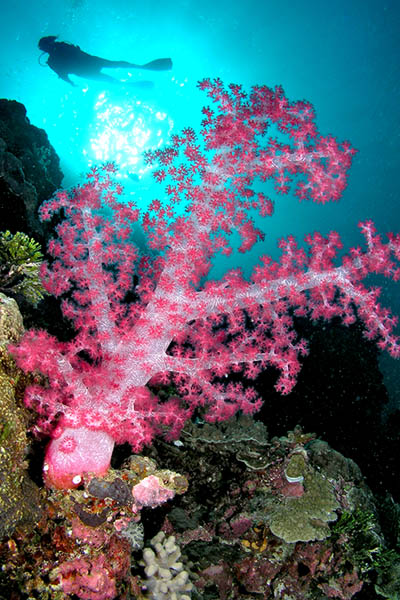
Text and photos by Yvette Cardozo, Bhoyet Etpison, and Wayne Hasson
Vol. 21, No. 10 June/July, 2018
My first trip to Palau was … good grief! … 25 years ago. So when I returned not too long ago, I expected what I’ve seen in so many other dive spots from yesterday. I was afraid it would be a shadow of its former self.
Silly me. This was Palau, one of the Pacific’s premier dive locations. And one of the very first places to realize its treasure and take steps to protect it.
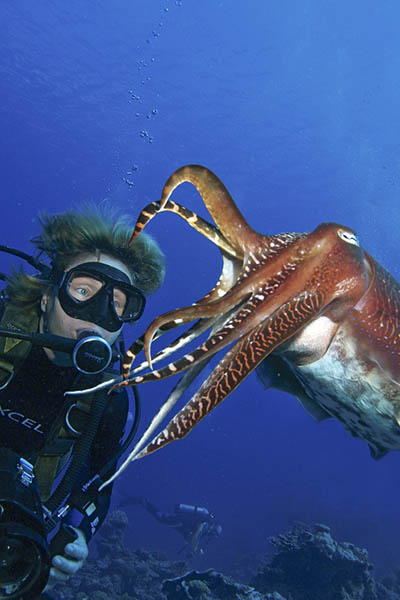
So there I was, 80 feet down, peering at a three foot stalk of neon pink soft coral when suddenly the sky above darkened. It was not a cloud but rather a huge school of snapper, easily over 1,000 of them, swimming overhead in perfect formation.
They dipped down towards me, forming a silver wall and then in an instant, they turned in unison and were gone.But the ocean was far from empty. The snapper were replaced by a soup of life … waves of blue and orange anthias, so many pyramid butterfly fish they looked like a swarm of insects, a mini wall of barracuda, half a dozen sharks. And, for a final touch, the resident Napoleon wrasse, a five-foot blue green puppy of a fish, stopped two inches from my nose.
This was Blue Corner, Palau’s most famous scuba dive site and for good reason. The “corner” is a wedge of rock jutting west towards the Philippines, pointing into currents that bring nutrients which attract a tapestry of creatures. Small fish come to eat the microscopic life. Large fish come from the depths to eat the small fish. Schools of pelagic fish come from open ocean to eat the large fish. And sharks come in to swallow anything they can.
If it wasn’t for diving, it would be easy to miss Palau, which sits seven degrees north of the Equator, southwest of Guam. Still, it’s not tiny — covering a 400 mile long archipelago with a barrier reef that surrounds 586 islands.
Like so many island nations in the Pacific, Palau’s modern history was one long parade of occupations. The British arrived in the late 1700s, the Spaniards in the 1800s, then Germany, the Japanese and finally the Americans. Today, Palau runs itself as an independent island nation with an American style constitutional democracy.
Aboard my boat for that trip, the Palau Aggressor II, we were just getting started on our week of diving. A live-aboard is like a large yacht … in this case nine staterooms with 18 passengers … whose sole purpose is scuba. The Aggressor’s mantra is “eat, sleep, and dive” and up to five dives a day honestly doesn’t give you time for much else.
Palau has 67 named dive sites and, I swear, we are trying to hit them all.
My favorite was a wreck; but it wasn’t the bullets, helmets, guns or sake bottles that caught my attention. It was the fishy soap opera going on atop the second boom. The Chuyo Maru was a converted cargo ship sunk, along with 38 other Japanese ships, on Mar. 30 and 31, 1944 as World War II ground to an end.
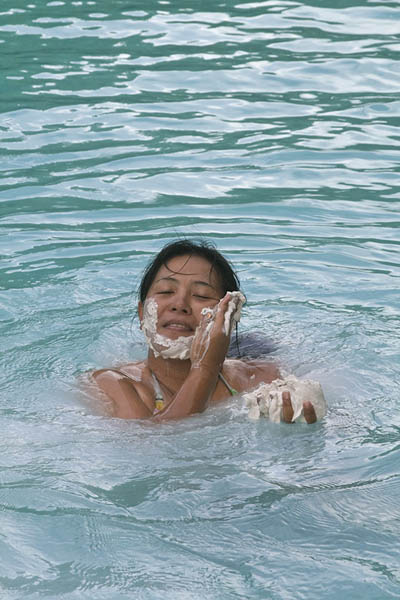
Several three-foot-long, rainbow-lipped giant clams had dug themselves in so deep, it’ was hard to tell where coral ended and clams began. Tufts of staghorn coral grew next to them, infused with clouds of tiny silver fish called glassy sweepers.
Three jack swam above, spooking the sweepers, which twitched back and forth in silver waves through the antlers. On top of this, a spotted grouper wandered lazily, sizing up his next meal. And woven throughout were several anemones with bright orange clownfish that darted at anyone coming near their home.
But the show wasn’t over. A bait ball of small fish appeared above me and, acting as one, the hundreds of fish nervously shifted back and forth while absolutely the largest, fattest barracuda I’d ever seen cut a swath of destruction through its center.
While my passion is fish … the larger the school the better … others in our group were after different things. Some wanted sharks. Others wanted exotic macro stuff. Still others wanted huge schools of fish.
And Ulong Channel, with its huge bait ball of fish, its turtles, its wrasses begging for hard boiled eggs, its enormous patch of lettuce coral spreading a good 500 feet and, of course, its sharks, had a bit of something for everyone including a current that made the whole thing run like a Disney ride.
What’s special about Palau, the boat’s captain asked? The Galapagos and Cocos have big animals. Papua New Guinea has exotic small stuff. Sulawesi has very, very exotic macro. The Solomon Islands have large schools of fish and great coral. Fiji has brilliant soft corals.
And Palau?
“Has them all. The diversity here is unmatched anywhere else.”
Plus, there’s plenty above water.
For WWII buffs, we had Peleliu, a 4.6 mile island that was the site of one of the bloodiest battles of the Pacific. What was supposed to be a weekend mop-up turned into a two month siege that left 13,000 dead for both countries.
“We’re still finding stuff … helmets, bottles, bayonets. Some of the shells are still live,” the island’s guide said. The rusty bits and pieces are now housed in a museum that once served as the main Japanese bunker.
There are also the Rock Islands … mushroom shaped islands topped with tufts of palms. They sit in the south central part of the Palau archipelago and are the remains of ancient, uplifted coral reefs.
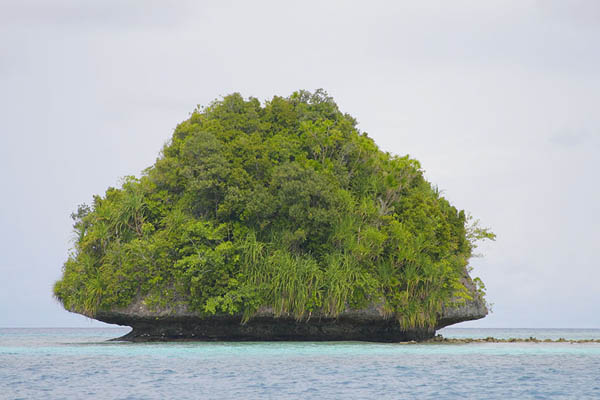
Each island, no matter how small, has a top knot of the thickest vegetation imaginable .. palms and leafy trees so dense, the green mat blends into a velvet blur. The islands are undercut, sometimes 40 feet, by a combination of chewing marine mollusks, acid rain water and erosion by waves.
The Rock Islands are also home to Jellyfish Lake.
When the Rock Islands rose, 62 salt water lakes were cut off from the ocean. Five have golden jellyfish that live on sugars made by algae and, so, have stings so weak, you can’t feel it. One lake was open to visitors and at the end of our week, when we needed a break from diving, we visited its eight million inhabitants.
Jellyfish Lake is a true mangrove lake, complete with hanging vines and cypress knees sticking out of the water. It’s muddy olive, with five foot viz but that only added to the surrealism of it all.
First there was one lone jellyfish … peach colored and translucent with a white filigree of gonads visible just under the cap. Then there were two, six, a dozen and suddenly, the water was milky with them.
Some jellies were the size of a thimble. Some were bigger than a grapefruit. And they all pulsed at different speeds … the small ones fast, the fast ones slow. It was one huge disjointed vibration. Finally, there were so many of them that the pulsing merged into a single froth … like swimming through giant champagne bubbles gone absolutely mad.
As we cut through this, the velvet jellies bumped our dive masks and bounced off our lips. They slid under our arms and between our legs.
It was a total giggle.
And like the rest of Palau, it was truly memorable.
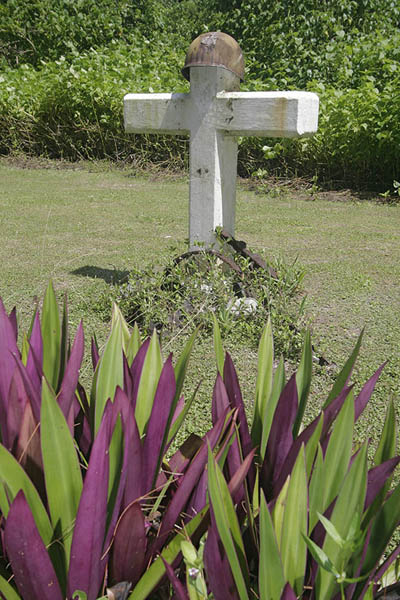
If you go:
The best diving weather in Palau is December through March. Mid-summer is rainiest and windiest. Water temperature is in the low 80s. Ashore, it’s hot and humid.
Visits to Jellyfish Lake have been suspended until the population of jellyfish recovers. The severe drought of 2016 combined with the effects of El Niño’s warmer water and increased salinity seem to be the reasons that millions of Golden Jellyfish have vanished.
Local currency is the US dollar and electrical outlets are North American.
The main town of Palau is Koror and the best place to buy storyboards (island legends carved in mahogany) is the local jail though if you want to see them carved, head for Tebang Wood Carving Shop.
Eco Info
In 1993, when scuba divers were first discovering this area, Palau realized it needed to preserve its treasures. While the Philippines, Indonesia and Papua New Guinea have more varieties of fish (3,000 vs 1,500) and coral (700 vs 450), overfishing and lax protection has taken its toll in those places.
But life in Palau is so spectacular that CEDAM, a marine conservation organization, included Palau in its list of the seven underwater wonders of the world, along with Australia’s Great Barrier Reef.
Large parts of Palau’s dive areas have been off limits to commercial fishing since 1997. Some areas are so protected, even diving is not allowed and permits are needed to dive the most popular areas. At present, snorkeling in Jellyfish Lake has been suspended.
Palau’s 67 named sites have more than 100 mooring buoys for boats to tie off so they won’t anchor on coral. There are strict rules against taking the smallest shell and divers are even asked to not wear gloves so they won’t be tempted to grab onto coral. There are also clam planting programs where visitors can plant baby “giant clams” in shallow water to help replenish the giant clam population. The Palau Pacific Resort has a clam planting program for its guests.
Palau for non-divers
Yes, two thirds of Palau visitors are scuba divers. But there’s plenty to do for non-divers.
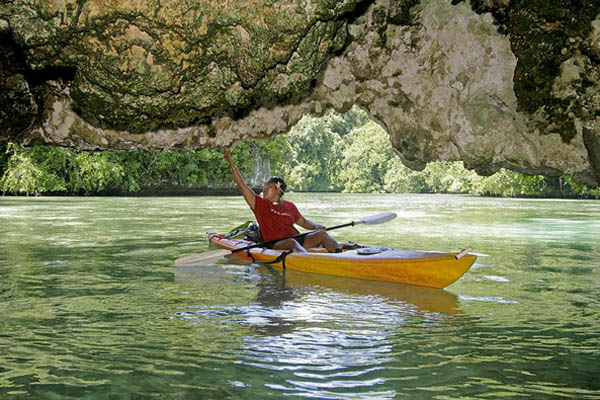
Kayak Tour — No spray skirts or rollovers with these kayaks. They are wide, stable, open plastic boats. You motor out on a skiff carrying the kayaks, then put in at a series of great places … swimming beaches where harmless rays and sharks circle your feet, islands with ancient ruins, caves where you can paddle into darkness or float through tunnels. All in all, this is a lazy day of paddling, looking and munching (coconut, local fruit and a provided lunch). (www.samstours.com)
Rock Island Tour — This is a true sampler of the islands. Milky Way Bay is coated with white, powder-fine, spa-quality mud … made by the same mollusks who have helped carve the mushroom shaped Rock Islands. Clam City has, of course, clams … hundreds of two metre bivalves with thick, iridescent lips in snorkel deep water. Snorkeling at Cemetery Reef is better than most dives elsewhere. Antler and lettuce coral lay a solid carpet on the shallow bottom with clouds of fish so thick, you can hardly see through them. There’s brain coral bigger than a Volkswagen and yard-wide anemones crowded with tiny Nemos.
Wood Carving — Where else would the local prison be a must-do shopping stop. Not exactly Sing Sing, most prisoners in the jail at Koror, Palau’s capital, are non-violent and earn money by carving local legends into mahogany “storyboards.” Prison carvings are cheaper but not necessarily best quality. For that, go to Tebang Wood Carving Shop, where you can also watch carvers at work.
For more information:
Palau Visitors Authority: www.visit-palau.com
Aggressor Fleet Ltd: www.aggressor.com
Sam’s Tours: www.samstours.com
Palau Pacific Resort: https://www.palauppr.com/en
Fruit Bat Soup — Mine came floating in coconut broth, complete with fur, wings, eyes, tiny nose and, ugh, teeth. The owner at Penthouse Cafe deftly dissected it with chopsticks, leaving me a mat of dark meat, though I could still make out those tiny ears.
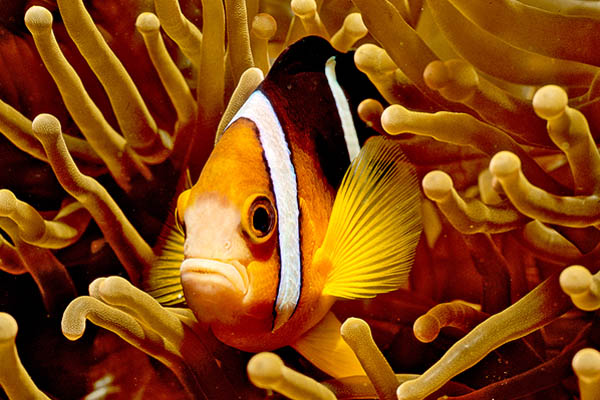
“The bats only suck the juice out of the fruit so inside, they are really clean,” my local friend said. It didn’t help when she added that people from Guam eat bat with their fingers, then end the meal by rubbing the musky, pungent juice on their faces. But the meat does taste like … yes, chicken. So it wasn’t all that bad … except for the wings that felt like cooked spinach. And all those little hollow bones.
